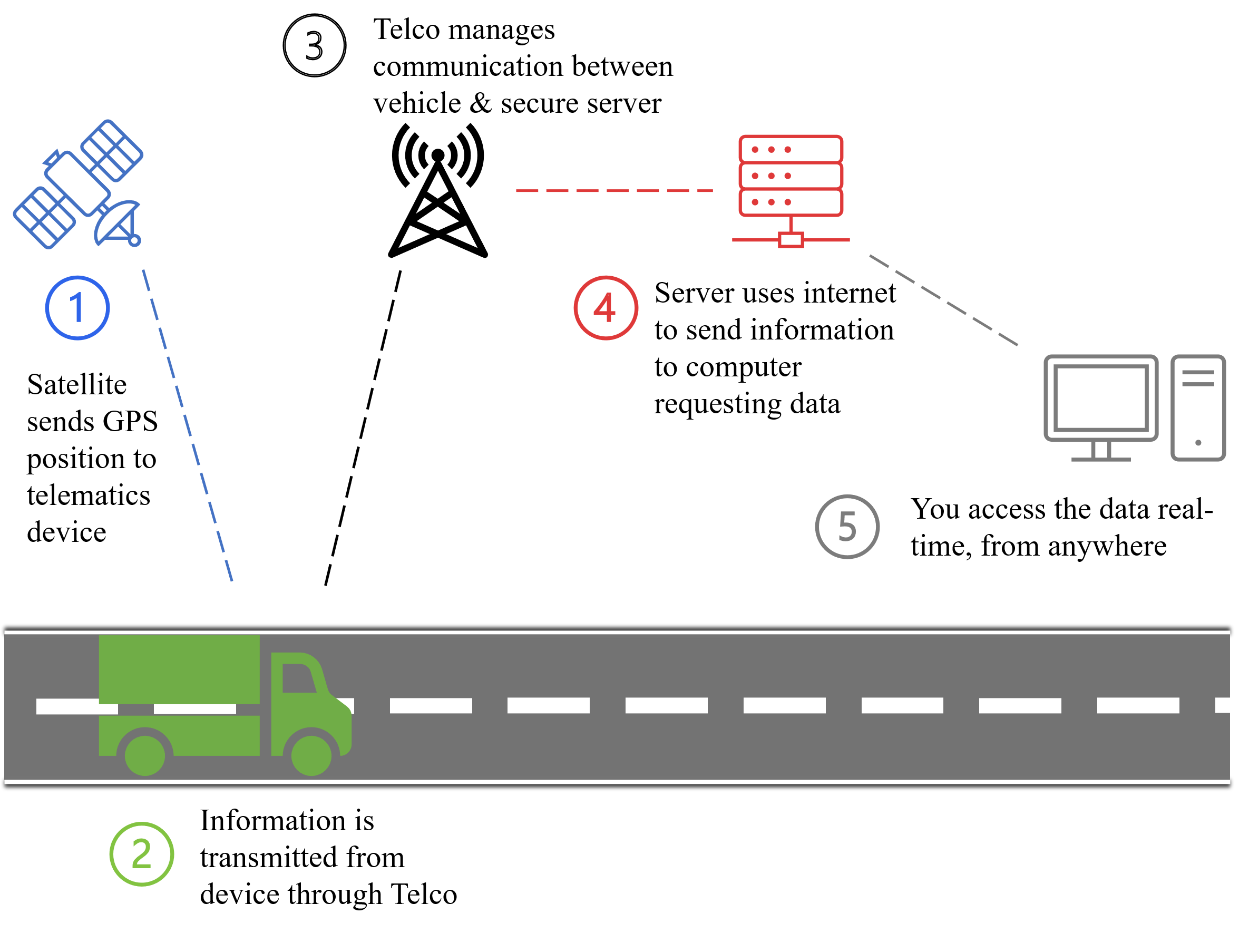
What is Telematics?
Telematics is the merging of the terms telecommunications and informatics. The “tele” comes from telecommunications and the “matics” is from informatics. Therefore, telematics is by definition the combination of those two terms.
Telecommunications is the transmission of information from different types of technologies through fast mediums such as wire, radio, satellite, or other electromagnetic systems. Basically, telecommunications are any form of communication done in a fast way using some sort of electricity. This allows us to communicate with people far away but at the same speed as if they were close. Examples include listening to your favorite radio station from Los Angeles when you are in San Diego, texting your family member happy birthday from a different state, and even older forms such as sending a telegram.
Informatics is the study of the structure, behavior, and interactions of natural and engineered computational systems. This is essentially information processing—or looking at how a device computes data and what it does with that data. For example, part of informatics could be looking at how a calculator returns 4 when a user types in 2 x 2. Or it can dive deeper into how a computer reads in binary data and runs different programs from it.
Telematics, then, deals with both the processing of information and resulting communication of that processed information. This term sprung about in the 1970s and has vastly grown as telecommunications networks have spiked with the emergence of the internet. Telematics help in many different fields, including fleet management.
Telematics in Vehicles
In the fleet management field, telematics and vehicle telematics are often synonymous. Vehicle telematics deals with devices processing vehicle information and communicating that to an outside source. External devices such as Positioning Universal’s FT7500 utilize vehicle telematics to provide fleet managers accurate GPS tracking and other valuable metrics. Likewise, using video telematics, devices such as the AI Fleet Camera Solution provide another angle of analysis by communicating video footage of important events to fleet managers.
How Telematics Work
The process of vehicle telematics at a higher level goes through 5 steps. In the figure below, we show the telematics process of GPS trackingcl.

- Data Processing
- Device processes data to be communicated to the end user
- For GPS tracking, this will be done via satellite signals sent to the vehicle. This is done automatically without any request from the device.
- Other actions use cloud computing or edge processing, which is where the device needs certain information and computes either using the cloud or by itself. Learn more here about edge vs cloud computing
- Vehicle communication
- Device sends the data (GPS position in our example) to a secure server through a Telecommunications company via wireless connection (or satellite communications)
- Telecommunication Company
- The Telco manages this communication between vehicle and secure server
- Server to Browser
- Secure server receives information and uses the internet to upload the information to any computer requesting the information
- This is usually accessed through a user interface that a fleet uses
- User Receives Information
- You receive the information from any device that connects to the internet
- Information is real-time and accessible from any location
Benefits of Telematics
Telematics offer a surplus of benefits, and almost all of them center around helping the fleet manager do their job best. The main benefits include fleet safety, visibility, cost reduction, and maintenance optimization.
Safety
Fleet safety is one of the most important benefits that telematics solutions can offer. Keeping drivers safe from thousands of miles away is a very difficult task, but telematics allows fleet managers to keep track of their drivers as if they were in the passenger seat. Features from devices like Positioning Universal’s FT7500 allow fleet managers to see when drivers are exhibiting good or bad driving behavior and adjust them accordingly through customized training programs. Likewise the AI Fleet Camera Solution allows managers to identify collision risks and other driving violations, and receive in cab as well as on road vision of those events.
Visibility
As illustrated through the GPS example above, fleet managers can have increased, real-time visibility of where all of their fleet drivers are. Having this visibility allows for better response times to trip issues (accident, vehicle failure, etc.) and adds to overall fleet safety of drivers.
Cost Reduction
Telematics can greatly reduce fuel costs by relaying the vehicle’s fuel consumption and idling time. By being able to monitor this, as well as the driver’s route performance, fleets can now save immensely on fuel costs as fleet drivers can adjust their routes to be more fuel efficient and managers can work with drivers to minimize vehicle idling time.
Maintenance Optimization
Since telematics devices such as the FT7500 connect to the vehicle through the CAN Bus, the device can utilize telematics to easily communicate diagnostic data such as engine load, fuel consumption, and more so that managers can set up a better schedule for maintenance checks. Have consistent, real-time reports of this information allows for smoother scheduling and less on road delays from uncaught vehicle issues.
Conclusion
In all, telematics deal with both processing information and then communicating that information to whoever needs it. By harnessing this process, vehicles can better communicate what is happening on the road. This helps fleet management operations immensely as vehicles thousands of miles away can be very well monitored on a real-time basis, which can not only help the fleet save on costs and maintenance, but more importantly can keep drivers and managers better connected and safer.
Author
Jennifer CurleyRelated posts
Navigating Rising Insurance Premiums: A Guide for Small-to-Medium-Sized Fleets
The transportation and logistics market faces several key challenges, including
On the Road: Exploring the Synergy of Machine Vision, AI, and Dashcams for Fleet Safety
Introduction to Machine Vision Integration with Dashcams In today’s increa
Streamlining Field Services with Intelligent Telematics Solution
Background Field Service companies have the unique challenge of managing a workf



Leave a Reply